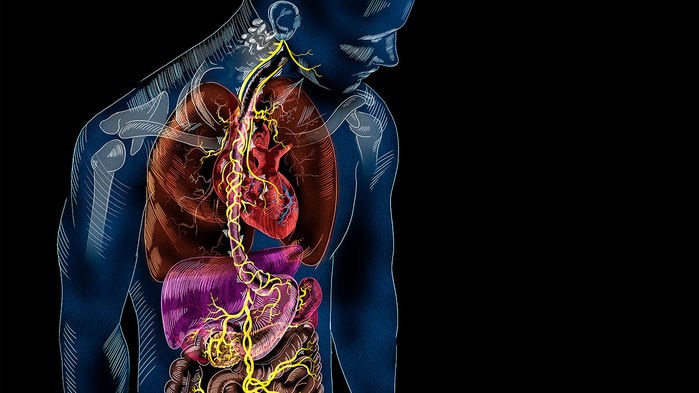Το έντερο συνδέεται άμεσα με τον εγκέφαλό σας

Στο ανθρώπινο έντερο βρίσκονται περισσότερα από 100 εκατομμύρια νευρικά κύτταρα - είναι ουσιαστικά ένας εγκέφαλος για τον εαυτό του. Και πράγματι, το έντερο μιλάει στον εγκέφαλο, απελευθερώνοντας ορμόνες στην κυκλοφορία του αίματος που, μέσα σε περίπου 10 λεπτά, ορμόνες μας λένε πόσο πεινασμένος είναι ή ότι δεν έπρεπε να φάμε μια ολόκληρη πίτσα.
Αλλά μια νέα μελέτη αποκαλύπτει ότι το έντερο έχει πολύ πιο άμεση σύνδεση με τον εγκέφαλο μέσω ενός νευρικού κυκλώματος που του επιτρέπει να μεταδίδει σήματα σε απλά δευτερόλεπτα. Τα ευρήματα θα μπορούσαν να οδηγήσουν σε νέες θεραπείες για την παχυσαρκία, τις διατροφικές διαταραχές και ακόμη και την κατάθλιψη και τον αυτισμό - οι οποίες έχουν συνδεθεί με ένα δυσλειτουργικό έντερο.
Μια μελέτη αποκαλύπτει "ένα νέο σύνολο οδών που χρησιμοποιούν κύτταρα του εντέρου για να επικοινωνούν ταχέως με ... το στέλεχος του εγκεφάλου" Daniel Drucker, Ινστιτούτο Ερευνών Lunenfeld-Tanenbaum στο Τορόντο του Καναδά.
Το 2010, ο νευροεπιστήμονας Diego Bohorquez του Πανεπιστημίου του Δούκα στο Durham της Βόρειας Καρολίνας έκανε μια καταπληκτική ανακάλυψη κοιτάζοντας το ηλεκτρονικό του μικροσκόπιο. Τα εντεροενδοκρινικά κύτταρα, τα οποία βρισκονται στο εντέρο και παράγουν ορμόνες που υποκινούν την πέψη και καταστέλλουν την πείνα, είχαν προεξοχές σαν πόδια που μοιάζουν με τους νευρώνες των συνάψεων που χρησιμοποιούν για να επικοινωνούν μεταξύ τους. Ο Bohórquez ήξερε ότι τα εντεροενδοκρινικά κύτταρα θα μπορούσαν να στείλουν ορμονικά μηνύματα στο κεντρικό νευρικό σύστημα, αλλά αναρωτιόταν επίσης αν μπορούσαν να "μιλήσουν" με τον εγκέφαλο χρησιμοποιώντας ηλεκτρικά σήματα, όπως κάνουν οι νευρώνες. Αν ναι, θα έπρεπε να στέλνουν τα σήματα μέσω του πνευμονογαστρικού νεύρου , το οποίο ταξιδεύει από το έντερο στο στέλεχος του εγκεφάλου.
Αυτός και οι συνάδελφοί του έκαναν έγχυση ενός φθορίζοντος ιού της λύσσας, ο οποίος μεταδίδεται μέσω νευρωνικών συνάψεων, στο έντερο ποντικών και περίμενε να αναλάβουν τα εντεροενδοκρινικά και τα συνεργικά τους κύτταρα. Αποδείχθηκε οτι τα συνεργικά κύτταρα ηταν νευρώνες του πνευμονογαστρικού νεύρου
Σε ένα τρυβλίο Petri, τα εντεροενδοκρινικά κύτταρα έφθασαν στους γαστρικούς νευρώνες και σχημάτισαν συναπτικές συνδέσεις μεταξύ τους. Τα κύτταρα προκάλεσαν και την εξοδο του γλουταμινικού οξέος, ενός νευροδιαβιβαστή που εμπλέκεται στη μυρωδιά και τη γεύση, το οποίο οι νευρικοί νευρώνες το προσέλαβαν μέσα σε 100 χιλιοστά του δευτερολέπτου - γρηγορότερα από ένα βλεφαρισμό.
Αυτή η οδός μέσω του πνευμονογαστρικού νεύρου είναι πολύ πιο ταχεία απο την κυκλοφορία των ορμονών μέσω της αιματικής οδού, για να φτάσουν οι ορμόνες απο το έντερο στον εγκέφαλο. ¨Το επόμενο βήμα είναι να μελετήσουμε κατά πόσο αυτή η σήμανση εντέρου-εγκεφάλου παρέχει στον εγκέφαλο σημαντικές πληροφορίες σχετικά με τα θρεπτικά συστατικά και την θερμιδική αξία του φαγητού που τρώμε¨.
Υπάρχουν μερικά προφανή πλεονεκτήματα στην υπερκείμενη σηματοδότηση του εντέρου, όπως η ανίχνευση τοξινών και δηλητηριάσεων, αλλά μπορεί να υπάρχουν και άλλα πλεονεκτήματα για την ανίχνευση του περιεχομένου των εντέρων στο πραγματικό χρόνο, λέει.
Πρόσθετες ενδείξεις σχετικά με το πώς τα αισθητικά κύτταρα του εντέρου μας ωφελούν σήμερα βρίσκονται σε ξεχωριστή μελέτη, που δημοσιεύθηκε σήμερα στο Cell. Οι ερευνητές χρησιμοποίησαν λέιζερ για να διεγείρουν τους αισθητήρες νευρώνες που νευρώνουν το έντερο σε ποντίκια. Η διέγερση με λέιζερ αύξησε τα επίπεδα ενός νευροδιαβιβαστή που ενισχύει τη διάθεση που ονομάζεται ντοπαμίνη στους εγκεφάλους των τρωκτικών, σύμφωνα με τους ερευνητές.
Συνδυασμένες, οι δύο εργασίες βοηθούν να εξηγηθεί γιατί η διέγερση του πνευμονογαστρικού νεύρου με ηλεκτρικό ρεύμα μπορεί να αντιμετωπίσει σοβαρή κατάθλιψη στους ανθρώπους, λέει ο Ivan de Araujo, νευροεπιστήμονας της ιατρικής σχολής του Icahn, ο οποίος ηγήθηκε της μελέτης Cell. Τα αποτελέσματα μπορεί επίσης να εξηγήσουν γιατί, σε βασικό επίπεδο, η κατανάλωση τροφής, μας κάνει να νιώθουμε καλά.
Emily Underwood Sep. 20, 2018
SCIENCE
Your gut is directly connected to your brain, by a newly discovered neuron circuit
The human gut is lined with more than 100 million nerve cells—it’s practically a brain unto itself. And indeed, the gut actually talks to the brain, releasing hormones into the bloodstream that, over the course of about 10 minutes, tell us how hungry it is, or that we shouldn’t have eaten an entire pizza. But a new study reveals the gut has a much more direct connection to the brain through a neural circuit that allows it to transmit signals in mere seconds. The findings could lead to new treatments for obesity, eating disorders, and even depression and autism—all of which have been linked to a malfunctioning gut.
The study reveals “a new set of pathways that use gut cells to rapidly communicate with … the brain stem,” says Daniel Drucker, a clinician-scientist who studies gut disorders at the Lunenfeld-Tanenbaum Research Institute in Toronto, Canada, who was not involved with the work. Although many questions remain before the clinical implications become clear, he says, “This is a cool new piece of the puzzle.”
In 2010, neuroscientist Diego Bohórquez of Duke University in Durham, North Carolina, made a startling discovery while looking through his electron microscope. Enteroendocrine cells, which stud the lining of the gut and produce hormones that spur digestion and suppress hunger, had footlike protrusions that resemble the synapses neurons use to communicate with each other. Bohórquez knew the enteroendocrine cells could send hormonal messages to the central nervous system, but he also wondered whether they could “talk” to the brain using electrical signals, the way that neurons do. If so, they would have to send the signals through the vagus nerve, which travels from the gut to the brain stem.
Top of Form
Bottom of Form
He and colleagues injected a fluorescent rabies virus, which is transmitted through neuronal synapses, into the colons of mice and waited for the enteroendocrine cells and their partners to light up. Those partners turned out to be to vagal neurons, the researchers report today in Science.
In a petri dish, enteroendocrine cells reached out to vagal neurons and formed synaptic connections with each other. The cells even gushed out glutamate, a neurotransmitter involved in smell and taste, which the vagal neurons picked up on within 100 milliseconds—faster than an eyeblink.
That’s much faster than hormones can travel from the gut to the brain through the bloodstream, Bohórquez says. Hormones’ sluggishness may be responsible for the failures of many appetite suppressants that target them, he says. The next step is to study whether this gut-brain signaling provides the brain with important information about the nutrients and caloric value of the food we eat, he says.
There are some obvious advantages to superfast gut-brain signaling, such as detecting toxins and poison, but there may be other perks to sensing the contents of our guts in real time, he says. Whatever those are, there’s a good chance the benefits are ancient—gut sensory cells date back to one of the first multicellular organisms, a flat creature called Trichoplax adhaerens, which arose roughly 600 million years ago.
Additional clues about how gut sensory cells benefit us today lie in a separate study, published today in Cell. Researchers used lasers to stimulate the sensory neurons that innervate the gut in mice, which produced rewarding sensations the rodents worked hard to repeat. The laser stimulation also increased levels of a mood-boosting neurotransmitter called dopamine in the rodents’ brains, the researchers found.
Combined, the two papers help explain why stimulating the vagus nerve with electrical current can treat severe depression in people, says Ivan de Araujo, a neuroscientist at the Icahn School of Medicine at Mount Sinai in New York City, who led the Cell study. The results may also explain why, on a basic level, eating makes us feel good. “Even though these neurons are outside the brain, they perfectly fit the definition of reward neurons” that drive motivation and increase pleasure, he says.








